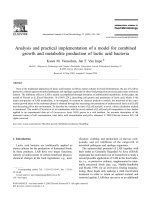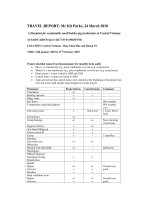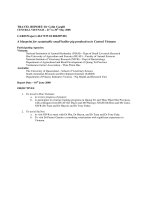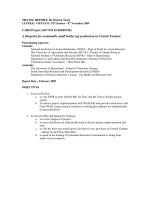holcim positioned for sustainable growth theophil h schlatter cfo ubs global basic materials conference june 9 2010 holcim ltd
Bạn đang xem bản rút gọn của tài liệu. Xem và tải ngay bản đầy đủ của tài liệu tại đây (604.47 KB, 25 trang )
Holcim – Positioned for Sustainable Growth
Theophil H. Schlatter – CFO
UBS – Global Basic
Materials Conference
June 9, 2010
Phu My Bridge, Vietnam
© Holcim Ltd 2010
1
Strategy
–
sustainable
development
2
Positioning
–
capture
future
growth
3
Conclusion
© Holcim Ltd 2010
UBS – Global Basic Materials Conference
2
June 9, 2010
Holcim's success in strategy execution –
Local management leveraged by global standards
Product segments 2009 Net sales per segment 2009
Cement
Clinker
•
202.9 million tonnes
production capacity
•
154 cement and grinding
plants
•
Sales: 131.9 million
Net sales CHF 21.1 billion
59%
Aggregates
tonnes
32%
9%
•
485 aggregates
plants
•
Sales: 143.4 million
Op. EBITDA per segment 2009
Op. EBITDA CHF 4.6 billion
Other
construction
tonnes
6%
85%
materials
&
services
•
1,457 RMX plants
•
114 asphalt plants
•
Sales of ready-mix
concrete: 41.8 million m
3
•
Sales of asphalt: 11.0
million tonnes
9%
Cement
Aggregates
Other Construction
Materials and Services
3
© Holcim Ltd 2010
UBS – Global Basic Materials Conference
June 9, 2010
Holcim's Strategy –
Base for value creation and sustainable growth
Goal
Strateg
y
Creatio
n of Value
Product Focus
Geographic
Diversification
Local Management
Global Standards
Mindsets
Sustainable
Environmental
Better
Cost
Permanent
Marketing
Human
Resources
Corporate
Social
Performance
Management
Innovation
Excellence
Responsibility
Base
© Holcim Ltd 2010
People
Triple Bottom Line
UBS – Global Basic Materials Conference
4
June 9, 2010
Concept of Triple Bottom Line
World Business
Council for
Sustainable
Development
(WBCSD)
Triple bottom line means optimization of financial, ecological
and social performance.
This
translates
into
•
Climate and energy
•
Sustainable products and
construction
UN Global
Compact
(UNGC)
•
Resources conservation
•
Occupational health & safety
(OH&S)
•
Stakeholder engagement
International Uni
on
for Conservation
of Nature (IUCN)
© Holcim Ltd 2010
•
Corporate Governance
•
Financial Performance
UBS – Global B
asic Materials C
onference
5
June 9, 2010
Climate and energy – sustainable performance
Replacing 4 old plants by one new state of the art production
facility:
•
Thermal energy: -43%
•
Power consumption:
-30%
•
CO
2
emissions:
-20%
•
NO
x
emissions:
-66%
•
SO
2
emissions:
-92%
US Cement plant
St. Genevieve (4 mtpa) operational since
August 2009
6
© Holcim Ltd 2010
UBS – Global Basic Materials Conference
June 9, 2010
Agenda
1
Strategy
–
sustainable
development
2
Positioning
–
capture
future
growth
3
Conclusion
© Holcim Ltd 2010
UBS – Global Basic Materials Conference
7
June 9, 2010
Global construction market: ~13% of global GDP
Largest construction markets 2009E
USD
bn %
USA
China
Japan
Germany
Spain
France
Italy
South Korea
India
UK
Canada
Brazil
Australia
Russia
Indonesi
a
Others
Total
1,313
17%
1,035
14%
592
8%
303
4%
292
4%
271
4%
262
3%
248
3%
247
3%
243
3%
218
3%
173
2%
157
2%
154
2%
138
2%
1,899
25%
7,542
100%
Global demand
•
Cement:
~
3bn t
•
Aggregates:
~20bn t
•
Read-mix concrete: ~1.6bn m3
Cement, aggregates and
ready-mix concrete markets
account for ~10% of global
construction
Source:
Global Construction 2020, Global Construction Perspectives, Oxford Economics, November 2009, JPM Full Sector Note 2009,
Global Cement Statistics, 18 year Database 1990 – 2008, Holcim Estimates
8
© Holcim Ltd 2010
UBS – Global Basic Materials Conference
June 9, 2010
Continuous growth in cement demand even in
recessionary environments
Global cement demand 1970 to 2009E (in million tonnes)
3500
3000
Oil
crisis
1973
Financial
crisis
1981
Financial
crisis
1990
Asian
crisis
1997
Reces-
sion
2002
Financial
crisis
2008
2500
2000
1500
1000
500
0
1970 1980 1990 2000 05 08 2010
CAGR 4.2% 2.7% 3.6% 7.4%
5.8%
Source:
Cembureau, Global Cement Statistics, 18 year Database 1990 – 2008, Holcim estimates
9
© Holcim Ltd 2010
UBS – Global Basic Materials Conference
June 9, 2010
Demand drivers – population growth and
urban rural
6.4
2.9
3.2
2.4
1.3
5.0
3.3
2.8
urbanization
World population
10
in billion
5
0
Emerging
markets
Mature
markets
Population in rural and urban areas
10
•
Likely little or even no population growth in most developed countries
while population growth in emerging countries will continue
•
In emerging and mature countries migration from rural areas into
urban agglomerations will continue
Source:
United Nations, World Population Prospects, March 2009 – in billion
10
© Holcim Ltd 2010
UBS – Global Basic Materials Conference
June 9, 2010
Global construction outlook
Largest construction markets 2009E Largest construction markets 2020E
USA
China
Japan
Germany
Spain
France
It
a
l
y
S
o
ut
h
Ko
re
a
India
UK
Canada
Brazil
Australia
Russia
5
0
2000 2030 20501970 1970 2000 2030 2050
Indonesia
Global ranking
1
2
3
4
5
6
7
8
9
10
11
12
13
14
15
China
USA
India
Japan
South
Korea
Germany
Spain
Russia
UK
Canada
France
Italy
Indonesia
Brazil
Australia
with Holcim presence
Global ranking
1
2
3
4
5
6
7
8
9
10
11
12
13
14
15
higher ranking
lower ranking
Holcim is very well positioned to capture growth opportunities
Source:
Global Construction 2020, Global Construction Perspectives, Oxford Economics, November 2009
11
© Holcim Ltd 2010
UBS – Global Basic Materials Conference
June 9, 2010
Holcim exposure is geared towards
emerging markets…
Mature markets (Western Europe,
North America, Australia, New Zealand)
Net sales in % of Group: ~49%
op. EBITDA: ~30%
Latin America
Net sales in % of Group:
~16%
Eastern Europe
Net sales in % of Group:
~7%
op. EBITDA:
~8%
Asia Pacific (w/o AUS, NZL)
Net sales in % of Group:
~22%
op. EBITDA:
~32%
Construction
output
forecast
CAGR
2010/2020
0% to <2%
2% to <4%
op. EBITDA:
~22%
4% to <6%
6% to < 8%
>8%
no forecast
Africa Middle East
Net sales in % of Group:
~6%
op. EBITDA:
~8%
dd
…which account for ~50% of net sales and
~70% of op. EBITDA
Reported consolidated cement capacities, net sales and op. EBITDA as 2009, China not consolidated
Source: Global Construction 2020, Global Construction Perspectives, Oxford Economics, November 2009, Holcim Estimates
12
© Holcim Ltd 2010
UBS – Global Basic Materials Conference
June 9, 2010
Holcim generates its EBITDA in countries with
GDP growth above average
GDP
Growth
[%]
(excl.
China)
2009 2010
2011
2012
World
-1.1%
3.9% 4.7% 5.2%
Mature
Market
-2.3%
2.7% 3.5% 3.9%
Emerging
Market
0.6%
5.4% 6.3% 6.8%
GDP
Growth
weighted
with
Holcim
op.
EBITDA
2009
per
country
[%]
(excl.
China)
2009
Holcim
op.
EBITDA
split:
Holcim World
1.3%
5.7% 6.4% 6.7%
•
Mature:
30%
Mature
Market
-1.7%
3.1% 3.8% 4.1%
•
Emerging:
70%
Emerging
Market
4.4%
8.2% 8.8% 9.0%
Source: Nominal GDP per Capita (at PPP) in USD: International Monetary Fund - World Economic Outlook Database (April 2010), Holcim estimates
13
© Holcim Ltd 2010
UBS – Global Basic Materials Conference
June 9, 2010
Agenda
1
Strategy
–
sustainable
development
2
Positioning
–
capture
future
growth
3
Conclusion
© Holcim Ltd 2010
UBS – Global Basic Materials Conference
14
June 9, 2010
Conclusions
•
The current global economic turmoil presents many
challenges, but also provides an opportunity to leverage the
competitive advantage that comes from our commitment to
environmental and social responsibility
•
Sound strategy and effective execution are the base for
ecological, social and financial performance
•
Demand for our products will grow
•
Growth areas are located in emerging markets while the need
for infrastructure in mature markets will support demand
•
Holcim is well positioned for sustainable growth!
Strength. Performance. Passion.
15
© Holcim Ltd 2010
UBS – Global Basic Materials Conference
June 9, 2010
Buildin foundations
for
society's
future
SAC's New Monte Rosa Hut, Switzerland
© Holcim Ltd 2010
Disclaimer
Cautionary statement regarding forward-looking statements
This presentation may contain certain forward-looking statements
relating to the Group’s future business, development and economic
performance.
Such statements may be subject to a number of risks, uncertainties
and other important factors, such as but not limited to (1) competitive
pressures; (2) legislative and regulatory developments; (3) global,
macroeconomic and political trends; (4) fluctuations in currency
exchange rates and general financial market conditions; (5) delay or
inability in obtaining approvals from authorities; (6) technical
developments; (7) litigation; (8) adverse publicity and news
coverage, which could cause actual development and results to differ
materially from the statements made in this presentation. Holcim
assumes no obligation to update or alter forward-looking statements
whether as a result of new information, future events or otherwise.
17
© Holcim Ltd 2010
UBS – Global Basic Materials Conference
June 9, 2010
Contact information and event calendar
Contact information
Bernhard A. Fuchs
Marco Knuchel
Binit Sanghvi
Investor Relations
Phone
+41 58 858 87 87
Fax +41 58 858 80 09
www.holcim.com/investors
Mailing list:
www.holcim.com/subscribe
Event calendar
August 19, 2010
Half-year results for 2010
November 10, 2010
Press and analyst conference for
the third quarter 2010
March 2, 2011
Press and analyst conference for
the annual results for 2010
May 4, 2011
Results for the first quarter 2011
May 5, 2011
General meeting of shareholders
© Holcim Ltd 2010
UBS – Global Basic Materials Conference
18
June 9, 2010









